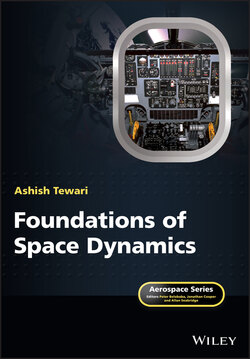Читать книгу Foundations of Space Dynamics - Ashish Tewari - Страница 22
1.3 Classification of Space Missions
ОглавлениеSpacecraft are classified according to their missions. A large majority of spacecraft orbit Earth as artificial satellites for observation, mapping, thermal and radio imaging, navigation, scientific experimentation, and telecommunications purposes. These satellites are classified according to the shapes and sizes of their orbits. A spacecraft orbiting a central body at altitudes smaller than the mean radius, , of the body, , is termed a low‐orbiting spacecraft. Examples of such spacecraft for Earth ( km) are the low‐Earth orbit (LEO) satellites, which orbit the planet in nearly circular orbits of km. Orbital periods of LEO satellites range from 90 to 127 min., and are mainly used for Earth observation, photo reconnaissance, resource mapping, and special sensing and scientific missions. The International Space Station is a manned LEO spacecraft with a nearly circular orbit of mean altitude, km. There are hundreds of active LEO satellites in orbit at any given time, launched by various nations for civil and military applications.
A medium‐Earth orbit (MEO) satellite has a period of about 12 hours. Examples of such spacecraft are the Global Positioning System (GPS) navigational satellites in circular orbits of altitudes about 20,000 km, and Molniya telecommunications satellites of Russia in highly eccentric elliptical orbits inclined at relative to Earth's equatorial plane.
The highest altitude of Earth satellites is for those in the geosynchronous equatorial orbit (GEO), which is a circular orbit in the equatorial plane of a period exactly matching a sidereal day, i.e., 23 hr., 56 min., 4.0904 s. This translates into an altitude of km. Since the orbital frequency of a GEO satellite equals the rate of rotation of Earth on its axis, such a satellite returns to the same point above the equator after each sidereal day, thereby appearing to be stationary to an observer on the ground. Hence, a GEO satellite is used as a telecommunications relay platform for signals between any two ground stations directly in the line of sight of the satellite. Due to the high altitude of the GEO satellite, a broad coverage of signals is provided to the receiving stations on the ground, and is the basis of modern television broadcasts and mobile telephone communications.
A small number of spacecraft are put into highly specialized lunar, interplanetary, and asteroid/cometary intercept orbits for the exploration of the solar system. Due to the typically large distances involved in their missions, which might include the time spent beyond the line‐of‐sight of Earth, such spacecraft must be fully autonomous in terms of their basic operations. The spacecraft which are sent to explore the outer planets (such as NASA's Voyager 1 and Voyager 2, Cassini, Galileo, and New Horizons) must also have an onboard electrical power source for charging their batteries, due to the unavailability of effective solar power (the sun is too dim at such large distances).
